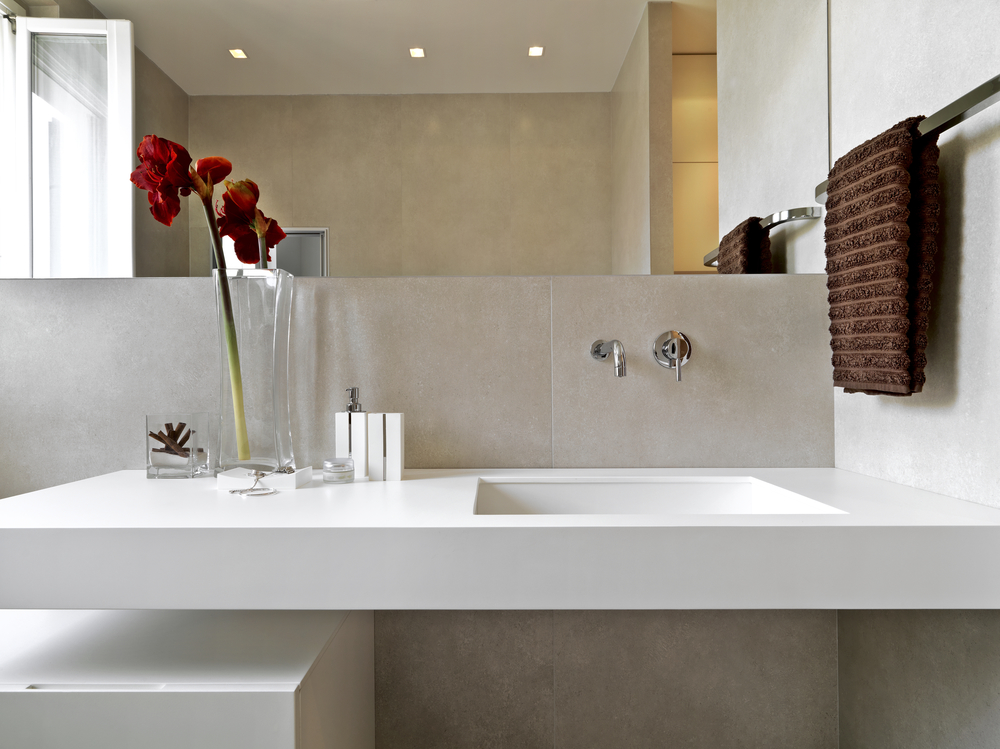Here are some tips for painting your bathroom. Bathrooms need painted more frequently than other rooms due to the high amount of traffic and moisture. They also contain more germs than the rest of the house/building, so keeping everything updated and clean is important to a healthy environment. Bathrooms are usually smaller than the rest of the rooms, so the painting service area is much smaller, which means you can most likely get it done in one weekend.
Choosing colors and sheen for painting your bathroom.
Painting your bathroom with the proper type of paint will ensure protective coatings and reduce the risk of mold or moisture build up. Typically you would want to use an eggshell or satin finish, as opposed to flat or matte finishes. There are certain brands of paint that do have a matte finish that are highly washable and mold resistant, check out Romabio’s website for more information.
Prep Is Key.
“By failing to prepare, you are preparing to fail.”
― Benjamin Franklin
“Prep is key” is a fact not to be taken lightly. First you should remove all outlet covers, hanging pictures and all towel & toilet paper racks. Some surface mounted mirrors are easily removable while others are not. Simply give it a careful tug and lift to see if it can easily be removed. You may have to get a helper for bigger ones. Large mirrors are most likely glued to the drywall with construction adhesive, so you will have to leave it on the wall and tape around it.
Removing the toilet can take some extra effort, but will save hassle and annoyance when you are painting.
Shower curtains should also be removed, as well as any toiletries, mats and garbage bins.
Cleaning prior to painting your bathroom
Now that everything is out of the way we are ready to paint….CLEAN!
Cleaning prior to painting is probably the most important variable to painting your bathroom, besides a steady hand, proper taping and using quality paint.
Bathrooms have unique crud, dirt, oils and soap scums that other rooms don’t see much of. Get yourself some heavy duty gloves and an eco-friendly bathroom cleaning product! An initial clean is urged before the paint preparations can begin. Use a quality, eco-sustainable bathroom cleaning product to safely remove soap scums and other oily residues that tend to stick to the walls of bathrooms. This step is not to be overlooked! If you skip the cleaning process, especially in a bathroom, the paint will not adhere to the walls and you will be left with a big mess!
After the initial clean, you can now begin….
More Prep before painting.
Paint Prep can be defined as the prep just prior to painting your bathroom. Like all steps in the painting process, it is equally as important as the next and the last step. This is when you inspect all the areas to be painted for any damages, holes to be filled, weird bumps…imperfections. Go over the entire surface are with a scraper and some spackle or joint compound, filling and scraping where you feel the need to.
Pro Painter Tip #1
Here’s a top secret painting tip for painting your bathroom. When doing your inspection prep work, wear a head mounted LED lamp and turn out all the lights, so that you only see what is directly in front of you. Doing this will keep your eyes focused and not run off, as they tend to do during this step.
Once the first round is done, dust off the baseboards and we can move on to…
Taping And Masking
Be sure to dust off the baseboards! Then use some tack cloth to remove any excess dust. Take your Painters grade tape, and lay it along all surfaces you don’t want to get paint on. Be very careful and precise when applying tape, it is an art form! Most likely, non of the walls are straight and the baseboards caulking job is probably not perfect. This can make taping an annoyance and a challenge! In some cases it is best to remove the old caulking and start over…but that is for another article. Use your discretion. It is best to go in a straight line with the tape rather than to use multiple pieces of tape per wall.
Use a “5-in-1” or a similar knife tool to go along the taped areas for proper adherence. This will ensure the paint does not “bleed through” and get under the tape.
Cover the floor and the sink area with drop cloths, shielding them from paint splatters. Splatters are not your friend! Safety glasses and hats are also highly recommended. If you are painting the baseboards, be sure to vacuum under them and tape along the floor.
Use a tape/paper Masking Machine for the shower to allow more protection against paint splatters. Plastic is not necessary and wasteful.
Finishing Touches On Prep
Ok. Everything is taped and shielded, it is almost time to paint! Go over any spackled areas that need another coat. Use fast drying so you can start painting your bathroom. After the spackle is dry, lightly sand everything, then take a damp sponge and “wet sand” to ensure the best outcome. Any spackled areas/filled holes are going to need at least a spot prime, so they don’t show up later as a different texture on the wall.
Skipping steps in the beginning of painting your bathroom can lead to peeling walls, rough or bumpy areas, even major mold growth!
Primer coating for proper adhesion
When changing colors it is highly recommended to prime beforehand. It is absolutely necessary to prime beforehand if you desire the “true color” that you chose. Tint the primer if you are painting over a dark or extreme color. Brush and roll one coat of primer to all surfaces you are going to paint. It is highly recommended to paint the ceiling and walls with a mold resistant, washable paint. (Mineral-based paints are affordable, mold resistant, washable, odorless, non-toxic and come highly recommended by this pro, who’s last name is Painter!) Be sure to have the exhaust fan running at all times when you begin your painting and priming, especially if you are using oil-based, acrylic, or latex paints, as they have toxic chemical solvents that are released into the air while being applied, drying and for years after the paint has been applied.
Applying Paint to your bathroom!
You are now ready to apply the paint! Painting actually takes the least amount of time to the painting process. Use a steady hand, quality brush and roller to apply the paint to your bathroom! This is very important, as you do not want brush marks or roller hairs showing up later when the paint is dry. Strain the paint, add the proper amount of water if using mineral-based paint, and mix well! Mix and stir your paint to ensure proper color and finish.
Pro Painter Tip#2
Take a damp sanding sponge, or even better is a lint roller, to the roller pad before using it. This will remove any loose hairs or fibers that can show up later on the walls!
Use a small bucket for the brush and roller pan. “Cut In” a small area with a steady hand and the brush, painting along the corners of a wall or around frames and baseboards, dipping every foot or two. brush out any heavy spots of paint to ensure an even coat. “Cut In” an area or about 3 feet in width, floor to ceiling, and then roll it with the roller and a not too much no too little amount of paint. Do not try to get perfect coverage on the first coat! Apply the paint evenly around the entire bathroom, let dry (1-12 hours, depending on type of paint..read label!). Apply a second coat, just as you did the first. Remove all tape immediately upon completing the painting process, the sooner you take the tape off the better!
Let paint dry completely before putting the bathroom back together. Paint any baseboards with a nice semi-gloss paint after painting your bathroom walls. This is suggested only in smaller rooms, but it is suggested because getting glossy paint on the walls can lead to problems later on.
These steps should leave you with a worry-free paint job!
We hope you enjoyed this article on Tips for painting your bathroom. Brush & Color is happy to serve you or help along the way in any of your interior painting projects.


